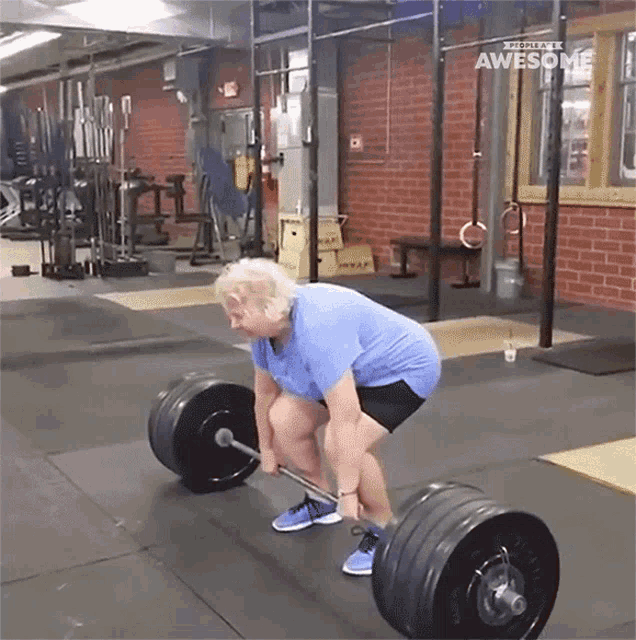
A reader recently sent me a great question:
“I’m always wondering if I’m pushing hard enough during strength training. My goals are to build strength and muscle—and not be a fragile old lady.”
This kind of question is more common than you might think! It’s something almost everyone wonders at some point: “How hard should I be working when I lift?”
Let’s break it down.
✅ 1. Do your muscles feel used during and after your workout?
You don’t need to destroy yourself to make progress, but you should feel like your muscles did some meaningful work.
That might show up as:
- Feeling tension and “work” in your muscles as you lift
- Feeling the weight start to unintentionally slow down as you fatigue in the middle of your set
- A light muscle “pump” post-workout
- Slight muscle soreness the next day (but nothing brutal)
- Feeling like you challenged yourself by the end of each set
If you finish your workout and feel like you could do the whole thing again immediately… that might be a sign it’s time to increase reps, weight, or sets.
✅ 2. What kind of soreness do you get (if any)?
Contrary to popular belief, soreness isn’t the only sign of progress, but it can give us clues.
Here’s what I look for:
- Mild soreness for 1–2 days? Great! You’re likely getting enough work in.
- Extreme soreness that lasts 4–5 days or more? That’s too much. Dial it back.
- Never sore at all? It might be time to push things a bit more intentionally, or switch up exercises.
Again, soreness is a signal, not a scorecard. It’s not something to chase NO MATTER WHAT, but it’s another piece of the puzzle in understanding what’s working and not working for you. 😃
✅ 3. Are you seeing progression over time?
Strength training is about challenging your body and then gradually increasing that challenge over time.
- Are you lifting heavier weights than you were 4–6 weeks ago?
- Are you doing more reps or more sets with the same weight?
- Are your movements feeling more stable, confident, or controlled?
If the answer is yes, you’re getting stronger. And that’s exactly what we want.
If not, it might be time to shift into a more structured plan, like a periodized program that gradually increases volume (sets and reps) or intensity (amount of weight lifted) over 6–12 weeks.
Note: as we age, we will naturally lose some amount of muscle and strength. This is totally normal! However, we can help reduce that loss with smart strength training.
Even though you may be lifting less in your 70s than you were in your 30s, you can still progress WITHIN a workout program to gradually increase the challenge. The principle of progressive overload still applies, you just adjust your starting point to whatever your body is capable of right now. 💪

🧪 Want to test your strength in a safe way?
Another way to check if you’re working hard enough?
Try what I call a litmus set.
Here’s how it works:
- Pick an exercise you’ve been doing consistently—something like bodyweight squats, push-ups, dumbbell rows, or a machine press.
- Do a solid warm-up. Get your body moving and your joints feeling good.
- Then go all out: Do as many quality reps as you can with good form. Stop when you know you can’t complete another clean rep.
This is easiest (and safest) with:
- Machines (you’re already “spotted”)
- Bodyweight movements (you can just stop without risk)
Less ideal:
- Free weight movements like barbell back squats or heavy bench press (unless you’ve got a spotter and plenty of experience)
What are we looking for?
Compare your litmus set to your usual working sets.
Example:
- If you usually do 3 sets of 10 reps and your litmus set gets you 12–13 reps, you’re right in that sweet spot within a few reps of failure.
- If you hit 20+ reps, on the other hand, you’re leaving 10+ reps in the tank during your normal workouts. That means it’s time to increase weight or reps to keep progressing.
Most muscle-building happens when you’re within 1–4 reps of failure on a working set. But if you don’t know what failure feels like, it’s easy to stop short.
A litmus set helps recalibrate your effort and builds confidence that you can push harder (safely) when it makes sense to.
💡 The Bottom Line
You don’t need to crush yourself to get stronger. But you do want your workouts to be purposeful and challenging enough to require your body to adapt.
Look for:
- Muscle tension (during the set)
- Muscle fatigue (after your workout)
- Mild soreness (especially at the beginning of a new workout program)
- Progress over time (reps, weight, technique)
- …and the occasional litmus set for clarity
And if you’re not seeing those? Let’s tweak your approach and help you find that sweet spot.
And remember! If you’re asking this question, that means you are already working out which is AMAZING!
You’ve got this.
– Coach Matt P.S. Need help finding the next step to progress in your workouts? Shoot me an email and I’ll see how I can help! 💪
🔥 Top Nutrition Picks for You! 🔥

ClearVite-CLA (K-105), Apex Energetics

Muscle Milk Zero Protein Shake, Vanilla Crème, 20g Protein, Zero Sugar, 100 Calories, Calcium, Vitamins A, C & D, 4g Fiber, Energizing Snack, Workout Recovery, Packaging May Vary 11.16 Fl Oz (Pack of 12)

Nature’s Garden Probiotic Yoggies Multi Pack, 21oz (Strawberry Yoggies 15×0.7 oz +Mixed Berry Yoggies 15×0.7 oz), Strawberry and Mixed Berry Yogurt Covered Snack, High Fiber, Real Fruit Pieces, No Artificial Ingredients, Healthy Snack for Adults













